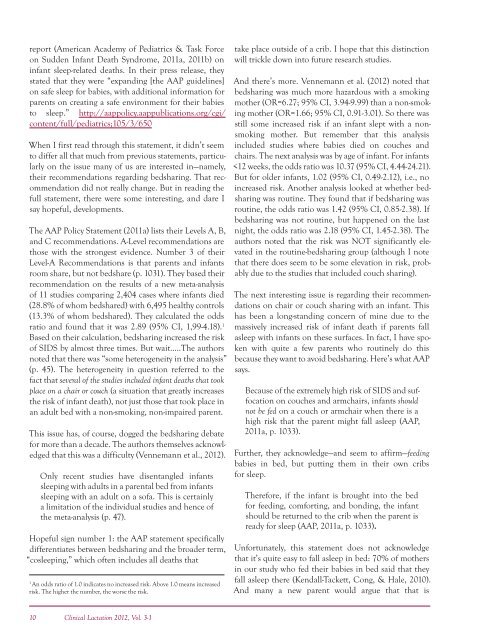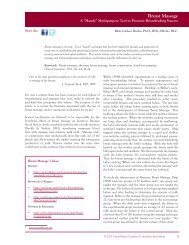Official Journal of the United States Lactation ... - Clinical Lactation
Official Journal of the United States Lactation ... - Clinical Lactation
Official Journal of the United States Lactation ... - Clinical Lactation
Create successful ePaper yourself
Turn your PDF publications into a flip-book with our unique Google optimized e-Paper software.
eport (American Academy <strong>of</strong> Pediatrics & Task Force<br />
on Sudden Infant Death Syndrome, 2011a, 2011b) on<br />
infant sleep-related deaths. In <strong>the</strong>ir press release, <strong>the</strong>y<br />
stated that <strong>the</strong>y were “expanding [<strong>the</strong> AAP guidelines]<br />
on safe sleep for babies, with additional information for<br />
parents on creating a safe environment for <strong>the</strong>ir babies<br />
to sleep.” http://aappolicy.aappublications.org/cgi/<br />
content/full/pediatrics;105/3/650<br />
When I first read through this statement, it didn’t seem<br />
to differ all that much from previous statements, particularly<br />
on <strong>the</strong> issue many <strong>of</strong> us are interested in—namely,<br />
<strong>the</strong>ir recommendations regarding bedsharing. That recommendation<br />
did not really change. But in reading <strong>the</strong><br />
full statement, <strong>the</strong>re were some interesting, and dare I<br />
say hopeful, developments.<br />
The AAP Policy Statement (2011a) lists <strong>the</strong>ir Levels A, B,<br />
and C recommendations. A-Level recommendations are<br />
those with <strong>the</strong> strongest evidence. Number 3 <strong>of</strong> <strong>the</strong>ir<br />
Level-A Recommendations is that parents and infants<br />
room share, but not bedshare (p. 1031). They based <strong>the</strong>ir<br />
recommendation on <strong>the</strong> results <strong>of</strong> a new meta-analysis<br />
<strong>of</strong> 11 studies comparing 2,404 cases where infants died<br />
(28.8% <strong>of</strong> whom bedshared) with 6,495 healthy controls<br />
(13.3% <strong>of</strong> whom bedshared). They calculated <strong>the</strong> odds<br />
ratio and found that it was 2.89 (95% CI, 1,99-4.18). 1<br />
Based on <strong>the</strong>ir calculation, bedsharing increased <strong>the</strong> risk<br />
<strong>of</strong> SIDS by almost three times. But wait…..The authors<br />
noted that <strong>the</strong>re was “some heterogeneity in <strong>the</strong> analysis”<br />
(p. 45). The heterogeneity in question referred to <strong>the</strong><br />
fact that several <strong>of</strong> <strong>the</strong> studies included infant deaths that took<br />
place on a chair or couch (a situation that greatly increases<br />
<strong>the</strong> risk <strong>of</strong> infant death), not just those that took place in<br />
an adult bed with a non-smoking, non-impaired parent.<br />
This issue has, <strong>of</strong> course, dogged <strong>the</strong> bedsharing debate<br />
for more than a decade. The authors <strong>the</strong>mselves acknowledged<br />
that this was a difficulty (Vennemann et al., 2012).<br />
Only recent studies have disentangled infants<br />
sleeping with adults in a parental bed from infants<br />
sleeping with an adult on a s<strong>of</strong>a. This is certainly<br />
a limitation <strong>of</strong> <strong>the</strong> individual studies and hence <strong>of</strong><br />
<strong>the</strong> meta-analysis (p. 47).<br />
Hopeful sign number 1: <strong>the</strong> AAP statement specifically<br />
differentiates between bedsharing and <strong>the</strong> broader term,<br />
“cosleeping,” which <strong>of</strong>ten includes all deaths that<br />
1<br />
An odds ratio <strong>of</strong> 1.0 indicates no increased risk. Above 1.0 means increased<br />
risk. The higher <strong>the</strong> number, <strong>the</strong> worse <strong>the</strong> risk.<br />
take place outside <strong>of</strong> a crib. I hope that this distinction<br />
will trickle down into future research studies.<br />
And <strong>the</strong>re’s more. Vennemann et al. (2012) noted that<br />
bedsharing was much more hazardous with a smoking<br />
mo<strong>the</strong>r (OR=6.27; 95% CI, 3.94-9.99) than a non-smoking<br />
mo<strong>the</strong>r (OR=1.66; 95% CI, 0.91-3.01). So <strong>the</strong>re was<br />
still some increased risk if an infant slept with a nonsmoking<br />
mo<strong>the</strong>r. But remember that this analysis<br />
included studies where babies died on couches and<br />
chairs. The next analysis was by age <strong>of</strong> infant. For infants<br />




